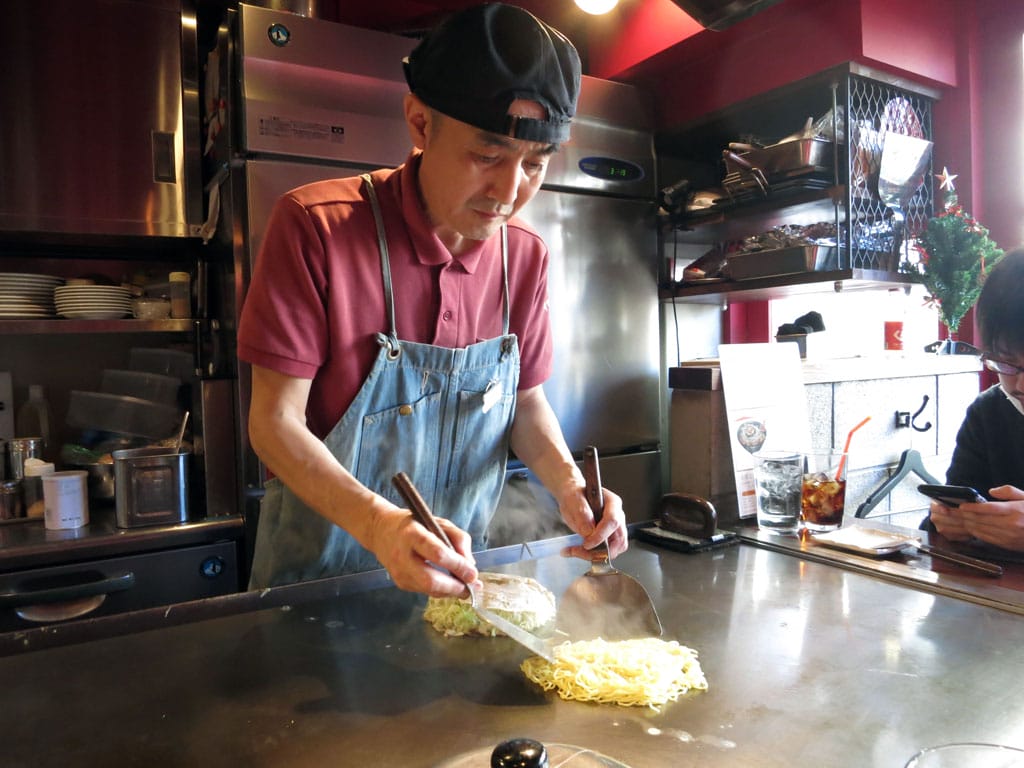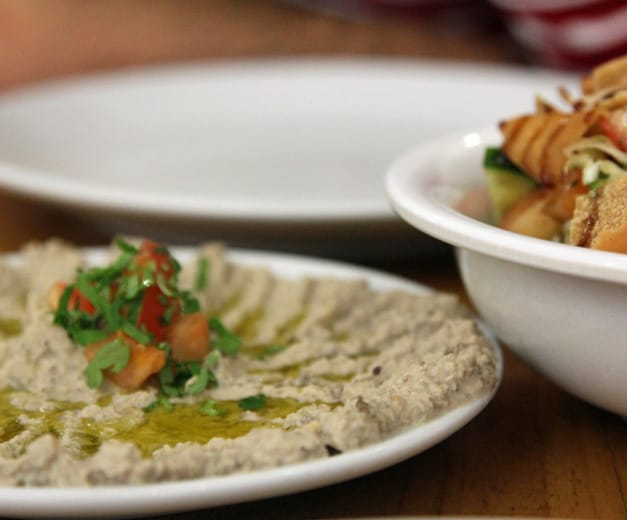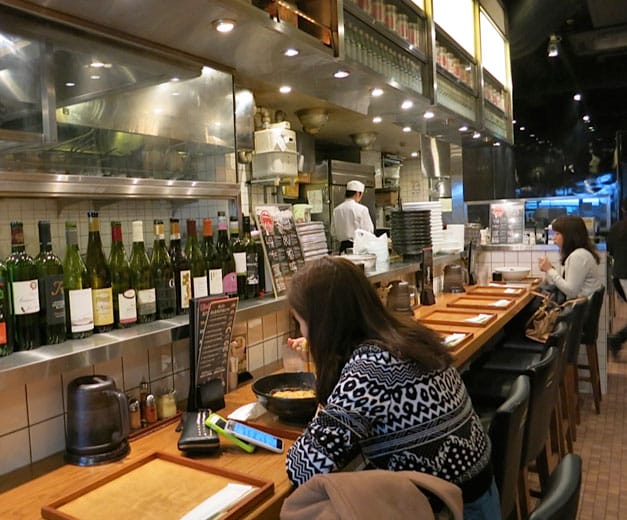What is it that’s so dizzyingly addictive about okonomiyaki? It might be the interactive DIY nature of building your own meal and serving it up from a Japanese teppan grill. Perhaps it’s the communal feeling of sitting around with a beer or two and cooking together. However, most likely is the fact that it’s so darn delicious and satisfying. It’s Japanese soul food that has somehow not quite reached the shores of many foreign countries.
Okonomiyaki is a flavorful pancake chock full of whatever ingredients appeal, cooked on a Japanese grill (okono means “cook whatever you like” and yaki means grill). In all parts of Japan it’s the secret second cousin to ramen in the family of fast food and cheap student eats. It’s a dish that has evolved slowly in Japanese culture as a means of spending time eating inexpensive and nutritious food, especially during times when there wasn’t a great deal of fresh produce or rice available.
The base of this omelet-style pancake is flour, grated nagaimo (yam), eggs, cabbage and a liquid such as water or dashi (kelp and dried bonito stock). The diner usually then includes add-ons such as green onions, meats, fish and vegetables selected from a menu. All of this is presented mixed together and raw to customers, who cook their own pancakes on the grill, tending it slowly over conversation and drink. The final product is topped off with otafuku sauce (similar to Worcestershire sauce), aonori (seaweed flakes), katsuobushi (bonito flakes), Japanese mayonnaise and pickled ginger.
Okonomiyaki most likely originated in Osaka, and the Kansai version is what is most widely eaten in Japan. But at Jyaken Nou, one has the opportunity to experience Hiroshima-style okonomiyaki prepared by a master. The Hiroshima version is noodle based, with a thin layer of batter, and is difficult to cook oneself. That’s where Fuku-san, the owner/chef comes in. Born in Funairi-machi in Naka ward, Hiroshima City, he builds, transforms and sculpts each order to savory perfection.
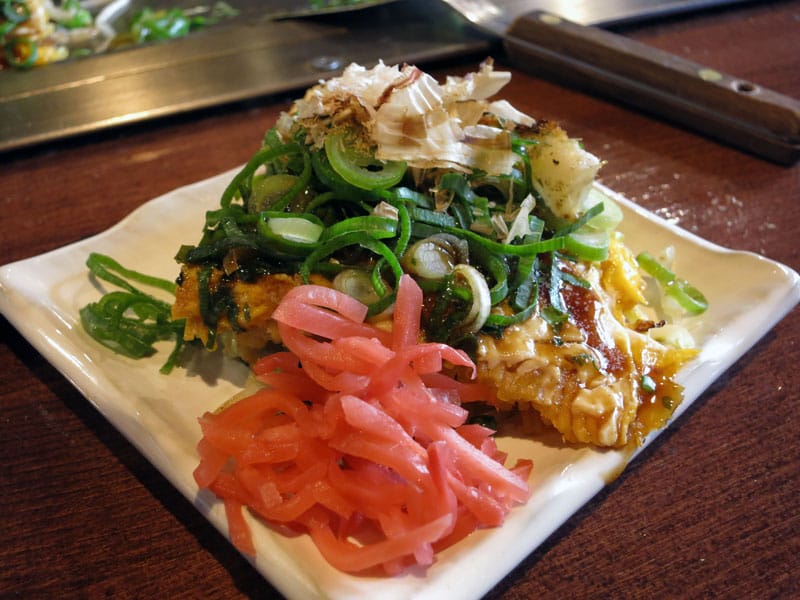
The place to sit is along the small counter fronting the teppan, which Fuku-san likes to boast costs in the $10,000 range and is almost two inches thick. On our last visit we chose the shrimp okonomiyaki and counted at least 15 steps in its preparation. First came batter on the grill, seasoned with some special spices. Next, a rain of ingredients as the batter started to form a small crepe-like base: chunky cabbage, gleaming bean sprouts, sliced scallions, pepper, popped Japanese rice and succulent slices of raw pork belly, all slicked over with oil and then flipped so the pancake sat atop the ingredients.
We sat drinking beer until it was time for the chef to oil the teppan and slam a tangle of noodles onto it. This was the beginning of the layering process that produces the Hiroshima okonomiyaki. The noodles were heaped on the mound and left to meld.
Succulent shrimp spiked with cayenne and pepper was calmly grilling nearby. Meanwhile, Fuku-san lightly fried an egg, its yolk still runny, then added it to the top. Another pancake went atop the tower, and by some kind of magic, he flipped the whole construction to continue grilling. Then came a secret sauce lathered over the finished pancake, with the shrimp nestled into the glaze.
After scattering scallions over the top, Fuku-san slid the result to the side of the teppan in front of our seats for presentation. We used a small trowel accompanying the pancake to section it and place a wedge on our plate, then scooped pickled ginger and bonito to our heart’s content from pots conveniently located along the counter. Next came a decorating frenzy using a squeeze bottle containing Japanese mayo and another with otafuku sauce. Finally, bedazzled by the many aromas of the contents, we scooped up hunks of the pancake using chopsticks.

Jyaken Nou also serves Hiroshima-style dandan noodles. These noodles, Chinese in origin, are usually served with a hot, spicy sauce. The version here is a generous bowl with pork, egg, spring onion, bean sprouts and a heaping of gorgeous Hiroshima oysters floating in it.
The restaurant tends to be seriously crowded at meal times, as locals and Hiroshima natives line up for their favorite soul food. At off-peak hours it’s usually possible to snag a seat at one of the few tables on the side and in the back, but the best spot, of course, is at the counter, where the magic happens.
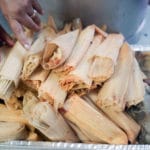 January 30, 2017 Street Carts of Desire
January 30, 2017 Street Carts of Desire
Editor's Note: In honor of the immigrants and refugees who have made their new home a […] Posted in Queens Migrant Kitchens, Queens February 4, 2014 Şam Şerif
February 4, 2014 Şam Şerif
Editor's note: We're sorry to report that Şam Şerif is now closed.
Turkey as a […] Posted in Istanbul March 13, 2015 Spajiro
March 13, 2015 Spajiro
The phrase “Japanese noodles” brings to mind so many things: soba, udon, ramen, […] Posted in Tokyo
Published on February 07, 2017
Related stories
January 30, 2017
QueensEditor's Note: In honor of the immigrants and refugees who have made their new home a better place for us all, this week we are running some of our favorite archived stories about those who have left a culinary mark on their adopted land. If you walk the length of Roosevelt Avenue from 69th Street to 111th…
February 4, 2014
IstanbulEditor's note: We're sorry to report that Şam Şerif is now closed. Turkey as a country does not deal in absolutes, even though some of its more bombastic citizens are known to. So when one hears the numerous bewildered complaints about Istanbul’s dearth of falafel and hummus, the correct response is not “Turkish food is…
March 13, 2015
TokyoThe phrase “Japanese noodles” brings to mind so many things: soba, udon, ramen, shirataki, somen – all with their variety of width, length and material. Some are eaten dipped in various sauces, while others are served swimming in broth. Japanese noodles are included in stews and with combinations of ingredients as well. They are eaten…







































